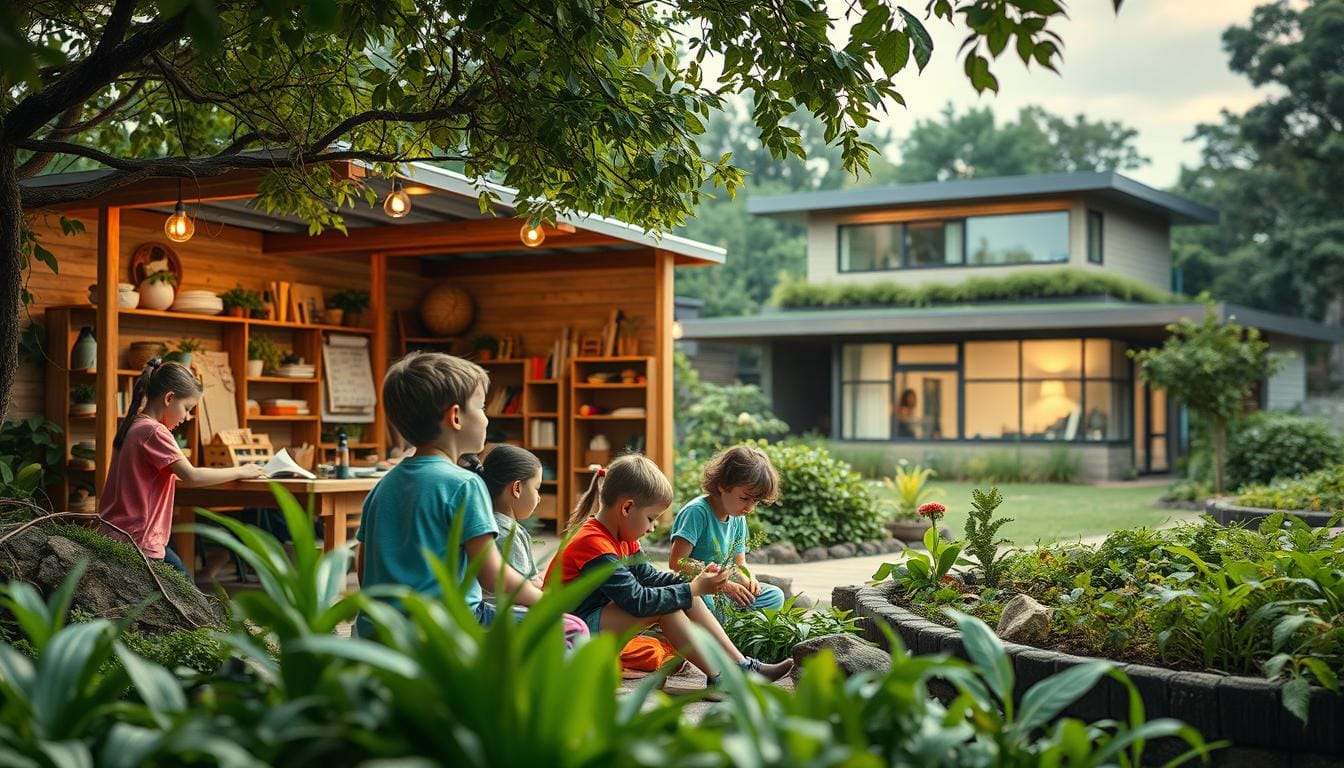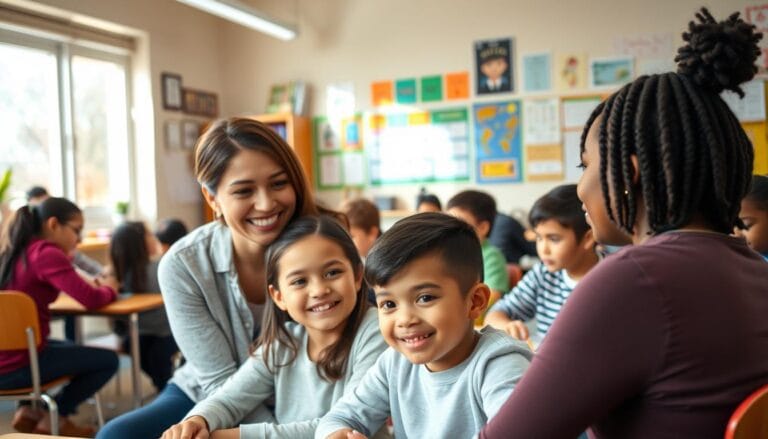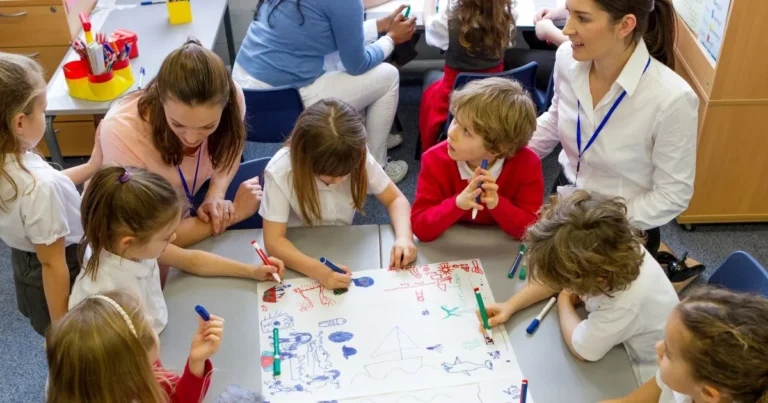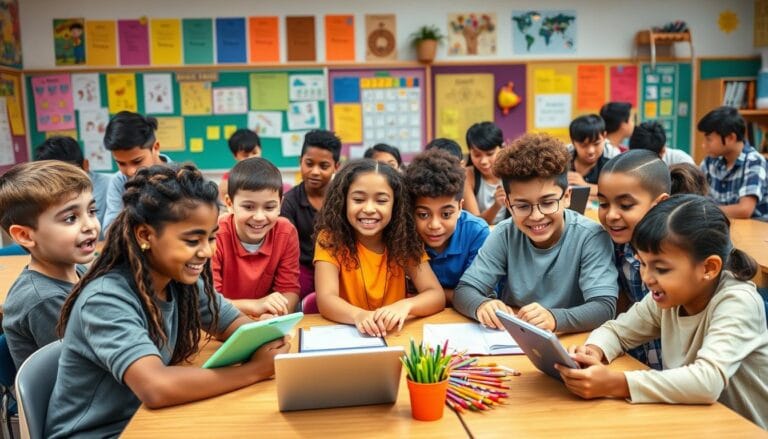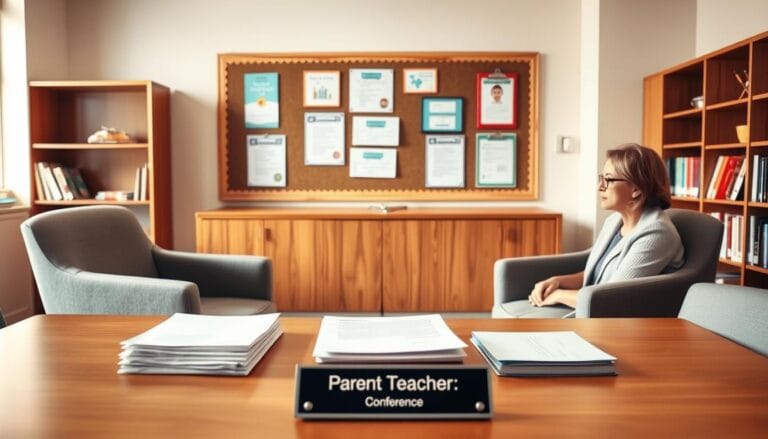Unschooling vs Homeschooling: Which Is Better?
Every parent wants the best for their child’s education. The choice between unschooling and homeschooling can be tough. These options offer a break from traditional school, giving families more freedom in their child’s learning.
Alternative education has changed how we see learning. Parents now focus on what works best for their children, moving away from strict classroom rules. Unschooling and homeschooling let families guide their child’s education, making it more personal.
Each method has its own beliefs, benefits, and challenges. You might prefer homeschooling’s structure or unschooling’s child-led approach. Knowing the differences can help you choose what’s best for your child’s growth and future.
In this guide, we’ll explore alternative education deeply. We’ll look at the main differences between unschooling and homeschooling. We’ll see how each can spark your child’s curiosity, support their learning, and prepare them for the future.
Table of Contents
Understanding Alternative Education Approaches
Alternative education is a big change from old-school classrooms. It offers new ways for parents and students to learn. Knowing about these options is key to choosing the right path for your child’s education.
Self-directed learning has changed how we see education. New data shows a big shift in how we learn:
- Approximately 4 million students are homeschooled in the U.S. as of 2024
- Between 10-20% of homeschoolers practice unschooling
- Parents increasingly seek personalized educational experiences
Defining Alternative Education
Alternative education is different from traditional schools. It focuses on what each student needs and wants to learn. It aims to create a flexible, student-focused environment that sparks curiosity and motivation.
The Rise of Non-Traditional Learning
“Education is not the filling of a pail, but the lighting of a fire.” – William Butler Yeats
More people are turning to alternative education because of issues with standardized tests and strict curricula. Parents want learning experiences that let kids follow their interests and think critically.
Evolution of Home-Based Education
| Educational Approach | Key Characteristics | Student Focus |
|---|---|---|
| Traditional Homeschooling | Structured curriculum | Standardized learning |
| Unschooling | Child-led learning | Personal interests |
| Microschools | Small group settings | Personalized instruction |
As alternative education grows, families find new ways to support their kids’ learning. The goal is to find a method that fits your child’s learning style and your family’s needs.
What is Traditional Homeschooling?
Traditional homeschooling is a structured way of learning outside of school. It’s for parents who want to teach their kids in a way that feels like school but is more flexible.
“Homeschooling is not about isolation, but about personalized learning tailored to your child’s unique needs.” – Dr. Brian Ray, Homeschool Research Expert
The curriculum for this method includes:
- Scheduled daily lessons
- Structured textbook-based learning
- Regular academic assessments
- Comprehensive subject coverage
In the 2020-2021 school year, about 3.7 million students were homeschooled. Parents choose this for more control over their kids’ education.
| Characteristic | Traditional Homeschooling |
|---|---|
| Learning Structure | Highly Organized |
| Curriculum Source | Standardized Textbooks |
| Assessment Method | Regular Testing |
| Parent Involvement | Direct Instruction |
Traditional homeschooling can use different teaching methods. The Classical Method breaks learning into stages. This ensures education is right for your child’s age and grows with them.
Families spend $600-$1,200 a year on school materials. This makes homeschooling a cost-effective option that still offers quality education.
The Philosophy Behind Unschooling
Unschooling is a new way of learning that breaks away from old teaching methods. It started in the 1970s with John Holt, who believed kids are born to learn. They do best when they can follow their interests.
At its heart, unschooling says kids are naturally curious. They don’t need a set curriculum. Instead, they learn by exploring what they find interesting.
Origins and John Holt’s Vision
John Holt was the first to talk about unschooling as a different way to learn. He said kids learn best when:
- They care about what they’re learning
- Learning happens naturally in everyday life
- There’s no strict schedule or tests
Core Principles of Child-Led Learning
Unschooling has a few main ideas that set it apart from regular school:
- Learning comes from the child’s curiosity
- There’s no set curriculum or tests
- Learning happens in many different places
“Children are born passionately eager to make sense of their world. They become fearful and hesitant only when adults label their efforts as ‘wrong’ or ‘stupid.'” – John Holt
Natural Learning Process
Unschooling sees learning as a natural, ongoing thing. About 20% of homeschooled kids follow this path. They learn in places like libraries, museums, and outside.
By trusting kids’ natural learning, unschooling offers a flexible way to learn. It fits each child’s unique interests and how they grow.
Unschooling vs Homeschooling: Key Differences
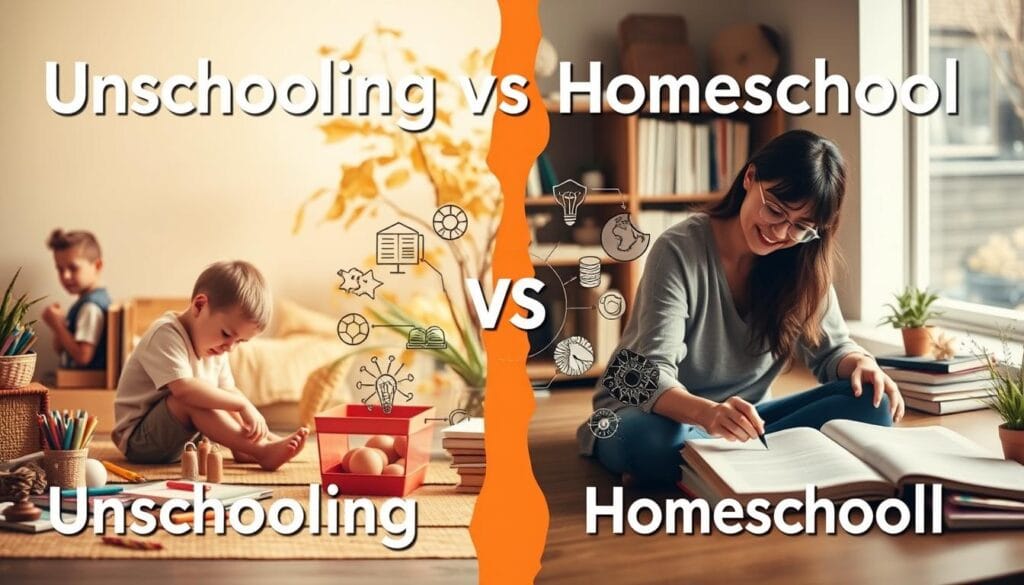
Unschooling and homeschooling are two unique ways to learn. They are different in how they are structured, what they teach, and their beliefs.
Looking at unschooling vs homeschooling shows us interesting ways to learn:
- Curriculum Approach: Homeschooling uses a set curriculum. Unschooling lets kids choose what they want to learn.
- Learning Flexibility: Unschoolers can explore freely. Homeschoolers follow a more set plan.
- Parental Involvement: Homeschool parents teach. Unschooling parents help kids learn by providing resources.
“Education is not the filling of a pail, but the lighting of a fire.” – William Butler Yeats
Here are some key facts about these learning styles:
- About 3-4% of homeschooled kids in the U.S. are unschooled.
- 70% of unschoolers learn through real-life experiences.
- 55% of unschooling parents let kids choose what they learn.
Choosing between unschooling and homeschooling depends on your family’s values and your child’s needs. Both ways can help kids love learning.
The Role of Parents in Both Approaches
Understanding the role of parents in alternative education is key. Whether you homeschool or follow an unschooling lifestyle, your role is crucial. Your involvement shapes your child’s educational path.
Parent as Teacher vs. Parent as Facilitator
In homeschooling, parents act as teachers, planning lessons and guiding learning. Unschooling, on the other hand, sees parents as facilitators. They support a child’s curiosity and interests.
- Homeschool parents create structured lesson plans
- Unschooling parents follow the child’s interests
- Both approaches require deep parental engagement
Time Commitment and Responsibilities
The time needed varies between homeschooling and unschooling. Homeschooling requires direct teaching, while unschooling needs ongoing support for learning environments.
| Homeschooling | Unschooling |
|---|---|
| Structured daily lessons | Spontaneous learning opportunities |
| Specific teaching hours | Continuous learning environment |
| Curriculum-based progress tracking | Interest-driven skill development |
Creating Learning Environments
Your home is a key learning space. Homeschooling means setting up study areas and gathering materials. Unschooling focuses on creating a stimulating environment that encourages curiosity.
“Education is not the filling of a pail, but the lighting of a fire.” – William Butler Yeats
Both homeschooling and unschooling require creativity, patience, and dedication. Choose an approach that fits your family’s values and your child’s learning style.
Curriculum and Learning Methods

Creating a homeschooling curriculum is a big task. You must think about what your child needs to learn. There are two main ways to homeschool: structured learning and self-directed learning (unschooling). Each has its own benefits for your child’s education.
Structured homeschooling means following a set plan. Parents use:
- Predetermined educational materials
- Scheduled learning times
- Standardized testing and assessments
- Specific learning objectives
Unschooling, on the other hand, lets kids learn on their own. They follow their interests and curiosity. About 15-25% of homeschooled kids learn this way.
“Learning is not the product of teaching. Learning is the product of the activity of learners.” – John Holt
You can mix both methods in home education. Many families use a mix of structure and freedom. Around 40% of homeschoolers do this.
When picking a homeschooling curriculum, think about your child’s learning style and goals. The right choice can make learning fun and exciting.
Studies show that homeschooled kids often do better than public school kids. About 25% of homeschooled students score above 90% in important subjects. This shows how well-personalized learning can work.
Social Development and Community Involvement
Learning to interact with others is key in the unschooling lifestyle. Parents might worry about their kids’ social skills when they choose not to go to school. But, there are many chances for kids to meet new people and get involved in their communities.
Being part of the community is important for kids’ social growth. Unschooling and homeschooling families can easily find ways to meet others and build strong social networks.
Building Social Skills
You don’t need a classroom to learn social skills. Homeschooling can offer more real-life social experiences through:
- Community classes and workshops
- Local sports teams
- Volunteer opportunities
- Interest-based clubs
- Collaborative learning groups
Community Resources and Activities
Many places in your community are great for homeschooling families. Libraries, museums, parks, and recreation centers often have special programs for home-educated kids.
“Social learning happens everywhere, not just in traditional classrooms.” – Homeschool Educator
Peer Interaction Opportunities
Unschooling doesn’t mean kids won’t meet other kids. 87% of studies show homeschooled kids do well socially. Kids can meet peers through:
- Homeschool co-ops
- Community theater
- Field trips
- Online learning communities
- Scouting programs
By looking for different social experiences, families can help their kids make friends and build strong relationships.
Academic Progress and Assessment
Exploring homeschooling and self-directed learning, it’s key to understanding how kids progress academically. Traditional tests often miss the mark when it comes to learning outside of school.
Parents in homeschooling get to see their kids’ learning up close. This way of learning focuses on each child’s growth and natural talents, not just grades.
“Learning is not the product of teaching. Learning is the product of the activity of learners.” – John Holt
- Natural observation replaces formal testing
- Progress tracked through daily interactions
- Emphasis on skill mastery over grade-level metrics
In self-directed learning, how we measure success changes. Kids show what they know by doing, not just by passing tests. About 10-20% of homeschoolers prefer this way, seeing learning as a natural process.
Some key ways to check on learning include:
- Portfolio documentation
- Project-based evaluations
- Skill demonstration
- Narrative progress reports
With around 3 million homeschooled students in the U.S., new ways of checking learning are becoming more accepted. Parents see that kids learn in their way, not always in a straight line. This makes old-school tests less reliable.
Your child’s learning journey can be unique and rewarding. By using flexible ways to check on learning, we can make education more meaningful and personal.
Legal Requirements and Compliance
Understanding homeschool laws can be tricky. Each state in the U.S. has its own rules for homeschooling and unschooling. Families need to know these laws to ensure a good education for their kids.
Homeschool laws differ a lot from state to state. Some places have few rules, while others have strict ones. Knowing your state’s laws helps you follow them and give your kids a great education.
Key Legal Considerations
- Verify state-specific homeschooling laws
- Understand notification requirements
- Maintain appropriate educational records
- Meet subject and assessment guidelines
“Education is not the filling of a pail, but the lighting of a fire.” – William Butler Yeats
Texas is a great example of homeschooling freedom. The Texas Supreme Court ruled in 1994 that parents have the right to homeschool. Homeschools in Texas are seen as private schools, with few rules to follow.
| State Requirement | Typical Compliance |
|---|---|
| Curriculum Coverage | Reading, Math, Grammar, Spelling, Citizenship |
| Registration | No mandatory statewide registration |
| Assessment | Minimal standardized testing requirements |
For unschooling families, keeping records is crucial. Unschooling gives a lot of freedom, but most states want to see that kids are learning. Keeping a portfolio, journal, or tracking learning helps meet legal needs.
When choosing homeschool methods, focus on your child’s growth and follow state laws. Do your research, prepare well, and talk to local education officials. This will help your homeschooling or unschooling journey go smoothly.
Making the Right Choice for Your Family
Choosing the right educational path for your kids is a big decision. Unschooling and homeschooling both have their own ups and downs. They can greatly affect your family’s learning journey.
Evaluating Your Child’s Learning Style
It’s important to know how your child learns best. Think about these things:
- Do they learn best when they’re curious?
- Do they like to learn through seeing, hearing, or doing?
- Can they take charge of their learning?
- What are their emotional and social needs?
Family Lifestyle Considerations
Your family’s lifestyle is key in deciding between unschooling and homeschooling. Think about:
- How much time do you have to help with learning?
- Is your work and home schedule flexible?
- Do you have the money for learning materials?
- What values and goals do you have for your child’s education?
Resource Availability
Good home-based education needs the right resources. About 60% of homeschoolers use online learning to improve their education.
“The best education doesn’t happen at a desk, but through life experiences and personal exploration.” – Unknown
With 3.7 million homeschooled students in the U.S. and 25% unschooling, you’re not alone. Look at your family’s needs to make the best learning space.
Conclusion
Your journey into alternative education, like unschooling and homeschooling, shows a wide range of learning paths. About 3.7 million students now learn at home. Families are looking into deschooling, which questions old ways of teaching.
Success in alternative education starts with knowing your child’s learning style. Studies say 85% of unschooling families see more motivation in their kids. Also, 40% of homeschooled kids feel they get better at social skills than in school. Choose what’s best for your child’s growth and potential.
Each alternative education way has its benefits. Homeschooling offers a structured learning plan with flexibility. Unschooling lets kids lead their learning. About 65% of unschooled kids value making their own learning choices. The best choice depends on your family’s values, resources, and your child’s learning style.
As education changes, unschooling is becoming more accepted. By being open and listening to your child, you can make a learning space that fits them. This way, they’ll be ready for whatever comes next.


